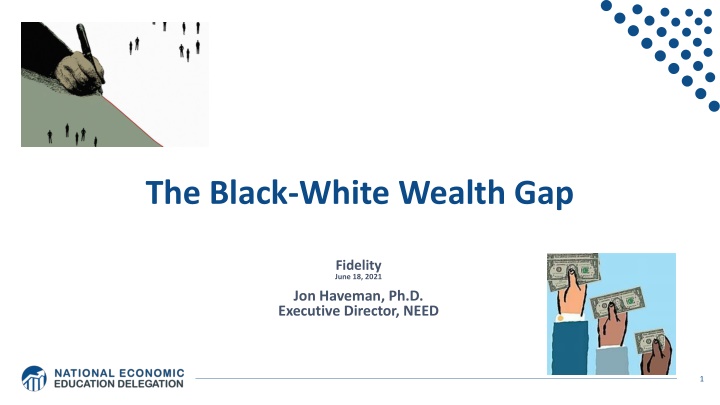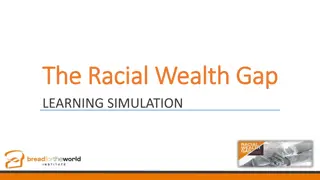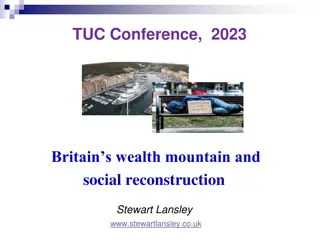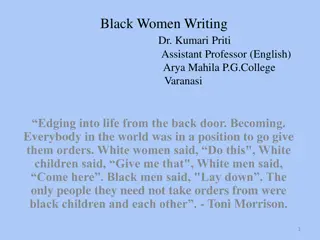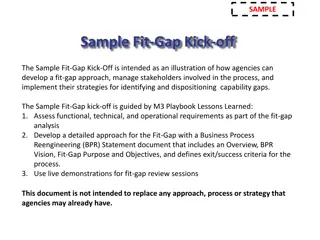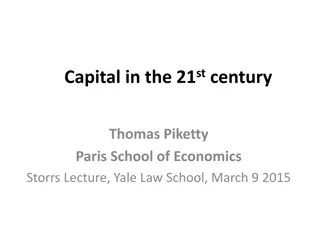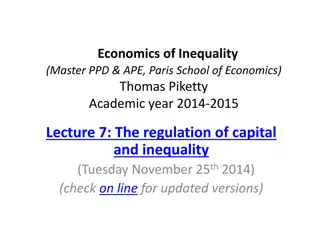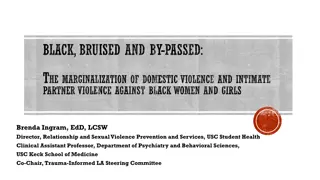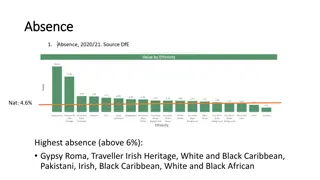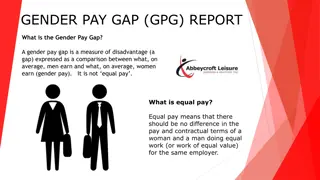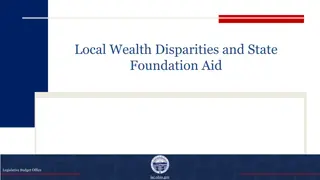Addressing the Black-White Wealth Gap
This presentation by the National Economic Education Delegation explores the disparities, importance, sources, implications, and policy solutions related to the Black-White wealth gap, providing evidence and insights into wealth accumulation and its impact on households.
Uploaded on Mar 13, 2025 | 0 Views
Download Presentation

Please find below an Image/Link to download the presentation.
The content on the website is provided AS IS for your information and personal use only. It may not be sold, licensed, or shared on other websites without obtaining consent from the author.If you encounter any issues during the download, it is possible that the publisher has removed the file from their server.
You are allowed to download the files provided on this website for personal or commercial use, subject to the condition that they are used lawfully. All files are the property of their respective owners.
The content on the website is provided AS IS for your information and personal use only. It may not be sold, licensed, or shared on other websites without obtaining consent from the author.
E N D
Presentation Transcript
The Black-White Wealth Gap Fidelity June 18, 2021 Jon Haveman, Ph.D. Executive Director, NEED 1
National Economic Education Delegation Vision - One day, the public discussion of policy issues will be grounded in an accurate perception of the underlying economic principles and data. Mission - NEED unites the skills and knowledge of a vast network of professional economists to promote understanding of the economics of policy issues in the United States. NEED Presentations - Are nonpartisan and intended to reflect the consensus of the economics profession. 2
Who Are We? Honorary Board: 54 members - 2 Fed Chairs: Janet Yellen, Ben Bernanke - 6 Chairs Council of Economic Advisers o Furman (D), Rosen (R), Bernanke (R), Yellen (D), Tyson (D), Goolsbee (D) - 3 Nobel Prize Winners o Akerlof, Smith, Maskin Delegates: 590+ members - At all levels of academia and some in government service - All have a Ph.D. in economics - Crowdsource slide decks - Give presentations Global Partners: 45 Ph.D. Economists - Aid in slide deck development 3
Credits and Disclaimer This slide deck was authored by: - Darrick Hamilton, Ph.D., The New School - Jon Haveman, Ph.D., NEED This slide deck was reviewed by: - Patrick Mason, Florida State University - Steven Craig, University of Houston Disclaimer - NEED presentations are designed to be nonpartisan. - It is, however, inevitable that the presenter will be asked for and will provide their own views. - Such views are those of the presenter and not necessarily those of the National Economic Education Delegation (NEED). 5
Outline Evidence of disparities Why wealth is important Sources of disparities Implications of disparities Policy solutions 6
What is Wealth? Income vs Wealth - Income is the flow of funds into a households each year. - Wealth is a household s NET asset holdings. o The value of all assets minus the value of all debts. Assets include: - Owned homes, cars, stocks, businesses, savings and checking accounts, pensions, life insurance Debts include: - Home mortgages, car loans, credit cards, and any other significant financial obligations (excl regular bills) 7
Evidence 8
Evidence of the Gap Mean is 7x Greater Median is 8x Greater 9
Wealth is More and More Concentrated 99th Percentile 2016 = 7x 1963 11 Source: Urban Institute
Black Household Incomes Relative to White 12 Source: pewsocialtrends.org
Widespread Household Wealth Pays Dividends To individuals in the household - Choices/Agency - Wealth is iterative And to broader society - Human capital development - Entrepreneurship and innovation 15
Household Level Benefits Choices/Life Agency - Finance higher education - Living in good neighborhoods - Saving for retirement - Capital to start a business - w/stand financial hardship - Better legal counsel - Exert political influence - Finance costly medical procedure - Bequests Wealth is iterative - Wealth begets more wealth. o Access to higher return investments. - Wealth transfers across generations. o Wealth is sticky. 16
Parental Wealth is Important Important pre-estate transfer effects on kids: - Influences human capital accumulation - Influences the returns to education - Adult incomes of offspring There are clearly enormous differences in wealth held by parents of Black and White children. And it s clear that nurture plays a big roll. 17
Tangible Benefits for the Broader Economy More human capital development Increased entrepreneurship Greater labor force participation Healthier labor force Less social unrest Less reliance on social programs Smaller stock of student loans 19
Events/Policies with Direct Wealth Implications Slave trade - The first deprivation Slavery 40 acres (and a mule) - The second deprivation - Discriminatory distribution of land. Freedmen s Bank - Lax oversite and dissolution. Jim Crow Laws & Economic Policy - Convict leasing, debt peonage, chain- gang, sharecropping, and lynching. Homestead Act - Discriminatory distribution of land. Land theft and destruction - E.g., Black Wall Street Tulsa, 1921 GI Bill - Discriminatory access Levittown Federal Housing Authority - Redlining And many more. 21
Results for Black Families Much lower accumulation of wealth than among White families. Implications: - Less financial contribution from parents to children. o More difficult access to higher education. o Less access to capital for business formation. - More likely to live in disadvantaged neighborhoods o Fewer role models. o Less access to quality education. - Disparities in the capacity availability of resources - to build wealth. 22
Potential Explanations: Differences in Educational attainment Home ownership Increased savings Financial literacy Entrepreneurship Soft skills and personal responsibility Wages Labor force participation Family structure Initial endowment 23
Wealth by Educational Attainment Educational Attainment Net Worth Median Net Worth Mean 71.0% No High School $22,800 $157,200 High School $67,100 $249,600 Some College $66,100 $340,600 16.1% College $292,100 $1,511,100 8.6% 4.3% 24 Source: Federal Reserve Board, Table data are 2016.
Educational Attainment Median Household Net Worth by Race and Education 25 Source: Darity, et al., What We Get Wrong About Closing the Racial Wealth Gap
Home Ownership: Households White Black 26
Home Ownership Net Worth Median Net Worth Mean Housing Status Renters $5,200 $91,100 Owner $231,400 $1,034,200 27
Wealth Equality Through Home Ownership? Well-documented evidence of historical and ongoing housing and lending discrimination. - Appraisals, buyers, lenders, local laws, covenants What about home prices in minority neighborhoods? Even if they buy, they won t get the appreciation of White neighborhoods. - Home values are 50% lower in majority Black neighborhoods. o 23% after adjusting for quality and amenities. 28 Source: Brookings, Home ownership while black
What Determines Differences in Home Ownership? Wealth of parents. Ability to borrow lending discrimination. - At all. - On equivalent terms to white borrowers. Local ordinances housing discrimination (often by income). Lower appreciation rates of homes in majority Black communities. 29
Increased Savings Historical evidence generated by economists ranging from Milton Friedman (1957) to Marjorie Galenson (1972) to Marcus Alexis (1971) to Gittelman and Wolff (2004) .. - All find that after accounting for household income, Blacks have a slightly higher savings rate than Whites. Do White investors have a greater tolerance for risk? - Controlling for income, this is not clear. - Access to and tolerance for higher risk investments is clearly correlated with income. 30
Financial Literacy Financial literary helps explain individual wealth differences within racial groups, but NONE of the wealth differences between racial groups. - The insufficient financial literacy argument is often leveled specifically at Black households. o The argument holds equally with regard to all households of comparable incomes. Controlling for household income, there is no difference in rates of asset appreciation between Black and White households. 31
Use of Payday Lenders 32 Source: Federal Reserve Bank of New York; Survey of Consumer Finances
Use of Payday Lenders 33 Source: Federal Reserve Bank of New York; Survey of Consumer Finances
Entrepreneurship: Rate of New Entrepreneurs 34 Source: Statistica
Explaining Differences in Entrepreneurship Disparities in access to capital: - Wealth disparities o Specifically differences in home equity. o Differences in wealth levels of friends and family. - Less likely to rely on banks and more likely to rely on credit cards. - Loans have higher int rates and more likely to be declined. - Less access to venture funds. Generally lower levels of education. Previous business ownership by family. Different stocks of relevant social capital. 35
Soft Skills and Personal Responsibility Reality - Black workers are crowded into service sector jobs. - Well represented in service, sales and office, and production, transportation, and material moving - Relatively less well represented in construction, extraction, and maintenance. Employability - Show up on time - Eye contact with customers - Dress well - Collaborative skills 36
Black-White Earnings Gap by Education 37 Source: https://www.frbsf.org/economic-research/publications/economic-letter/2017/september/disappointing-facts-about-black-white-wage-gap/
Equality of Income = Equality of Wealth / 38 Source: http://hartfordinfo.org/issues/wsd/FamiliesandChildren/Racial-Wealth-Gap-Brief.pdf
What is Fundamentally Responsible? Individual behaviors? Structural characteristics of the economy? History policy and otherwise? 41
Accounting for the Wealth Gap 30%+ Left Unaccounted for 43 Source: https://heller.brandeis.edu/iasp/pdfs/racial-wealth-equity/racial-wealth-gap/roots-widening-racial-wealth-gap.pdf
Categories of Policy Areas Housing - FHA and redlining Health Care Incarceration - Black incarceration rates are very high. Transportation - Interstate system Broadband - Access is inversely related to regional income Education Workforce Income support and stability Asset accumulation 45
Policy Options Global solutions that affect all source areas - Child Trust Accounts Baby Bonds - Guaranteed minimum income Addressing racial disparities directly - Reparations o Aggressive affirmative action. o A new Homestead Act. o Heavily investing in Black communities. - Labor and other laws that address discrimination o Enforce more aggressively and make adjustments where necessary to increase efficacy. - Fundamental reorientation of asset building agenda. 47
More Specific Policy Options Limit the mortgage interest tax deduction and use the revenues to provide a credit for first-time homebuyers. Establish automatic savings and retirement plans. Reduce reliance on student loans while supporting success in postsecondary education. Offer universal children's savings accounts. Reform safety net program asset tests, which can act as barriers to saving among low-income families. Provide subsidies to promote emergency savings, such as those linked to tax time. 48 Source: Urban Institute
Buying and Banking Black Common Assertion: Marshalling the enormous purchasing power of the Black community will drive progress. - More than $1.3 trillion in buying power.* Common Assertion: Banking is a source of wealth creation. - Combining the wealth of Black Americans in Black banks could be a source of wealth creation. 49 * Source: https://www.newswise.com/articles/minority-markets-have-3-9-trillion-buying-power
Why the Short Circuiting of Black Banking? Category White Black Numbers of banks & credit unions - Total: - Black owned: Home Ownership (%) 73.7 45.0 Other Residential Property Ownership (%) 15.1 8.2 10,655 43 (0.4%) Residential Ownership (%) 75.8 12.5 They are very small - All Black owned: $5.8 Billion - JP Morgan Chase: $2.8 TRILLION Mean Asset Value (Thousands $) - Own Home 354.8 199.3 - Other Residential 430.6 173.6 Share of Res. Value (%) 80.0 5.7 50
